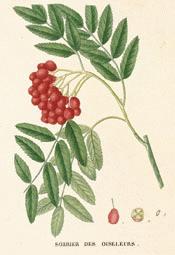

| |
Sorbus aucuparia
|
Ash, Mountain
Botanical: Pyrus Aucuparia (GAERTN.), Sorbus Aucuparia (LINN.)
Family: N.O. Rosaceae
---Synonym---Rowan Tree.
---Parts Used---Bark, fruit.
---Description---The Mountain Ash (Pyrus Aucuparia, Gaertn.) is not related to the true Ashes, but has derived its name from the similarity of the leaves.
In comparison to the true Ash, it is but a small tree, rarely more than 30 feet high. It belongs to the order Rosacece and is distinguished from its immediate relations the Pear, Crab Apple, White Beam and Wild Service Tree by its regularly pinnate, Ashlike leaves. It is generally distributed over the country in its wild state, but is also much cultivated as an ornamental tree.
All parts of the tree are astringent and may be used in tanning and dyeing black. When cut, the Mountain Ash yields poles and hoops for barrels.
Both the bark and fruit have medicinal properties.
The fruit is rather globose, with teeth at the apex and two to three seeded cells. They are used medicinally in either the fresh or the dried state.
---Constituents---The fruit contains tartaric acid before, citric and malic acids after ripening; two sugars, sorbin and sorbit, the latter after fermentation; parasorbic acid, which is aromatic and is converted into isomeric sorbic acid by heating under pressure with potassa; bitter, acrid and colouring matters. A crystalline saccharine principle, Sorbitol, which does not undergo the vinous fermentation, has also been found in the fruit.
The seeds contain 22 per cent. of fixed oil. It has been claimed that these seeds killed a child, apparently by prussic acid poisoning.
The bark has a soft, spongy, yellowishgrey outer layer and an inner thicker portion, with many layers of a light brown colour. It has a bitterish taste, but is odourless.
It is astringent and also yields amygdalin.
---Medicinal Action and Uses---In herbal medicine, a decoction of the bark is given for diarrhoea and used as a vaginal injection in leucorrhoea, etc.
The ripe berries furnish an acidulous and astringent gargle for sore throats and inflamed tonsils. For their anti-scorbutic properties, they have been used in scurvy. The astringent infusion is used as a remedy in haemorrhoids and strangury.
The fruit is a favourite food of birds. A delicious jelly is made from the berries, which is excellent with cold game or wild fowl, and a wholesome kind of perry or cider can also be made from them.
In Northern Europe they are dried for flour, and when fermented yield a strong spirit. The Welsh used to brew an ale from the berries, the secret of which is now lost .
AMERICAN MOUNTAIN ASH
Pyrus Americana (D.C.)
American Mountain Ash bark is derived from Pyrus Americana (D.C.), which has many local names.
It has similar properties to the bark of the European species and was formerly used as a tonic in fevers of supposed malarial type, where it was often substituted for cinchona bark.
No analysis of the bark of the American species has been made, though the fruit has been found to yield 4.92 to 6.6 of malic acid.
[Top]
Common Name Index
A MODERN HERBAL Home Page
Bear in mind "A Modern Herbal" was written with the conventional wisdom of the early 1900's. This should be taken into account as some of the information may now be considered inaccurate, or not in accordance with modern medicine.
© Copyright Protected 1995-2004 botanical.com

| 


